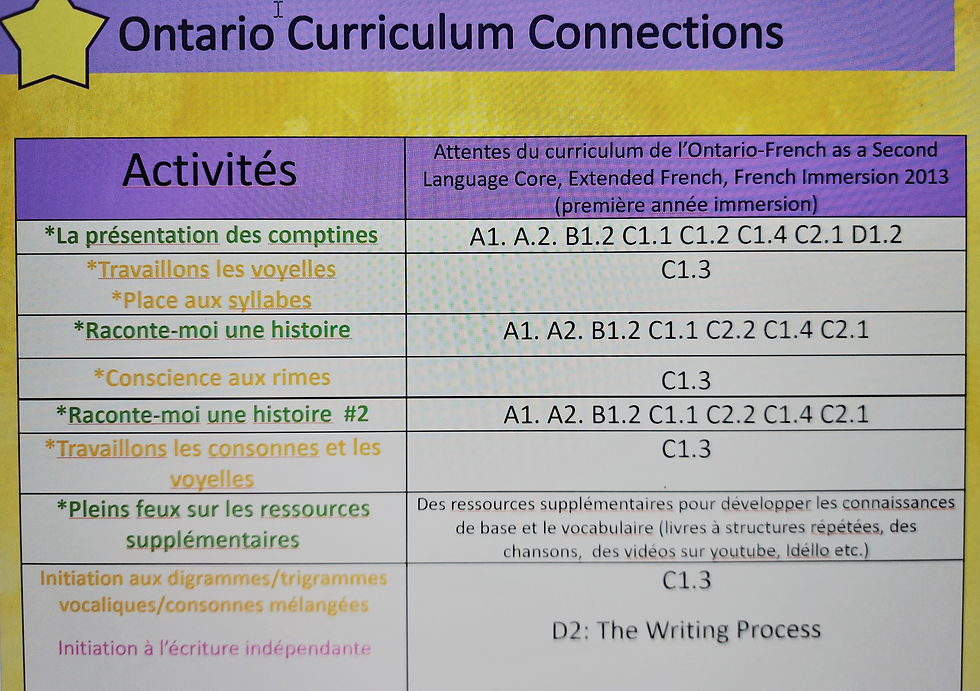How does Ecoutons, lisons, rions address language comprehension and word awareness skills?
- FrenchTwistsFSL

- Oct 26, 2020
- 3 min read
Language comprehension and word awareness skills are key ingredients necessary for becoming literate in any language. In the second language classroom, building background knowledge, vocabulary, inferencing skills along with word awareness skills requires material that is designed to address both of these essential building blocks of language. The point to ponder featured in this week's blog is as follows:
How does Ecoutons, lisons, rions address language comprehension and word awareness skills?
Simply put, all language learning with ELR starts with a text. The resource offers 15 texts in all: 5 comptines and 10 mini-narratives showcasing a particular vowel sound in French along with select consonants. The teacher knows which sounds are being taught as the units explicitly outline the sequence. The texts are used to teach language comprehension skills while key vocabulary from the texts are then used for word awareness activities. This is the basic premise of the resource.
The following chart outlines the resource's activities on the left and the Ontario curriculum expectations for grade 1 F.I. on the right. We chose to showcase expectations at the grade 1 level because most students learning a second language for the very first time will need to acquire the same basic linguistic skill set.

LANGUAGE COMPREHENSION
The language comprehension activities are highlighted in green. As previously stated, they are comprised of comptines and mini-narratives with references to additional French materials (i.e.: books, songs, IDELLO video clips etc.) that connect to the themes of the featured texts. The curriculum expectations covered correlate directly to the Ontario Ministry guidelines for gr. 1 French immersion in relation to:
Listening Skills:
- using listening comprehension strategies, particularly those strategies that help students infer to understand the intent and meaning of oral French texts;
Speaking Skills
-learn and use simple, familiar vocabulary to recount key story events;
Reading Skills:
-use reading comprehension strategies to gain a general awareness of story meaning using background knowledge, visuals, vocabulary previews etc.;
Writing Skills (Highlighted in pink):
-As the students French language skills increase, apply their knowledge of text and word awareness to write their own simple mini-narratives using the writing process.

WORD AWARENESS
The word awareness activities that follow each language comprehension activity are highlighted in orange. Familiar, contextualized vocabulary taken directly from the text are used to practise both letter-sound correspondences and phonological skills such as initial/final sound awareness, syllables, rhyme and sound segmentation.
Although section C 1.3 of the Ontario Ministry curriculum for grade 1 F.I. does not specifically refer to the direct teaching of phonological skills, the expectations do refer to the teaching of letter-sound correspondences and common spelling patterns to improve reading fluency (Ontario-French as a Second Language Core, Extended, French Immersion, page 208). It is our belief that phonological skills are just as important to teach as French letter sound-correspondences. The ELR resource offers activities that allow for the practice of both letter-sound correspondences and phonological skills in an explicit, sequenced manner to impact reading fluency.
One final point worth noting, contrary to Scarborough's rope whereby print concepts (i.e.: sentence awareness) are considered language comprehension skills, in the Ontario Ministry curriculum for FI, print concepts fall under section C 1.3. In the context of the ELR resource, sentence awareness is deemed as a language comprehension skill. Based on Dr. Scarborough's info-graphic, the place that words occupy in a sentence convey meaning. Understanding how words come together to communicate a message is far more a product of language comprehension than one of fluency.
Having established a clear understanding of how the ELR resource addresses both language comprehension and word awareness skills, our next blog will consider the following point:

HOW DO WE IMPLEMENT ELR ACTIVITIES IN THE CLASSROOM IN A WAY THAT COMPLEMENTS A TEACHER'S EXISTING LANGUAGE PROGRAM?
QUESTIONS?

If you have any questions about the information presented in this blog or about the ELR resource, please contact us via email at fumoguerriero@gmail.com. We would love to answer any points that you are currently pondering!
BIBLIOGRAPHY
Ontario Ministry of Education (2013). French as a Second Language: Core, Extended, French Immersion. ON: The Ontario Public Service


Comments